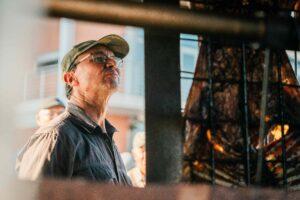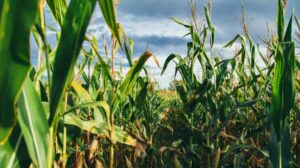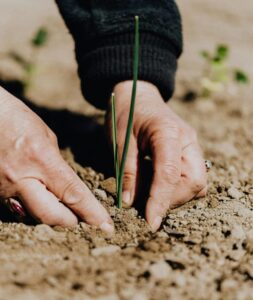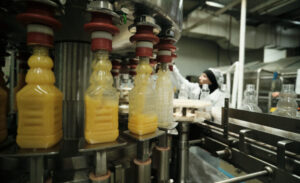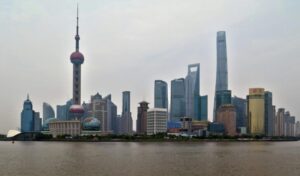Introduction
It is vital for any enterprise, let alone agricultural ones, to have a steady, reliable and cost-effective source of energy. The power constraints in South Africa mean that surely we should be looking at all our options now!
Renewable energy resources have a security of supply, being continually replenished. Start-up costs are increasingly affordable, and as tariffs increase the lower the break-even point (the time the system takes to pay for itself) becomes. After this, energy is sourced from the sun, wind, water or other natural/organic matter, and done so without pollution (why we call renewable energy technologies “clean technologies”).
The renewable energy sector is four times more employment-intensive than SA coal and nuclear (SAWEA, 2019). For South Africa, renewable energy could mean job creation, sustainable development, and a reduced burden on Eskom. It is also a sane, logical response to global warming.
See also the “Energy” and “Pumps & Generators” pages.
Batteries and inverters
Role players
- All Solar Renewable Energy Solutions
- Battery Centre
- Bundu Power
- Current Automation
- Dyness
- Earth Power Technologies
- ECOFLOW
- Enertec
- Eveready
- First National Battery
- Freedome Won
- Genpower
- JLiNX
- Kwikelec
- Maiden Electronics
- New Way Renewables
- Power Africa
- Sabat Batteries
- Solar Panel Energy
- Sub-Sahara Power Distributors
- The Sun Pays
- Willard Batteries
- Winglette
Further reference:
- Labuschagne H. 2025, March 21. “South Africa’s top solar panels and batteries”. My Braodband. Available at https://mybroadband.co.za/news/energy/584515-south-africas-top-solar-panels-and-batteries.html
- Labuschagne H. 2024, April 11. “Best inverters and solar panels for beating load-shedding”. My Broad Band. Available at https://mybroadband.co.za/news/energy/532035-best-inverters-and-solar-panels-for-beating-load-shedding.html
- Staff Writer. 2024, January 17. “The big problem with inverters and battery backups in South Africa”. BusinessTech. Available at https://businesstech.co.za/news/energy/743219/the-big-problem-with-inverters-and-battery-backups-in-south-africa
Biogas
Visit https://sabia.org.za.
What is biogas ?
A biogas digester (also known as a biogas plant), comprises a large tank in which biogas is produced through the decomposition/breakdown of organic matter (Such as food waste and plant matter) through a process called anaerobic digestion. It’s called a digester because organic material is eaten and digested by bacteria to produce biogas.
Biogas is a mixture of carbon dioxide and methane, that resembles liquid petroleum gas. Like natural gas, biogas is used as a fuel to produce electricity, to power farm equipment, for lighting applications, in gas cookers for cooking, and even as fuel for vehicles. Biogas is widely used across the world.
How does a biogas digester work?
A typical biogas digester has a container that holds organic matter and water, called slurry. A digester also has second container that holds the gas that has been produced after the organic matter is broken down. A series of pipes connect the slurry into the digester and from there connect to the container that will hold the gas output. There is also a transport system to take the biogas to where it will be used. The digester also has a mechanism for ejecting the residue.
Source: AGAMA BiogasPro
Role players
- AGAMA BiogasPro
- ARC for Agricultural Engineering
- Biogas Consulting SA
- Botala Energy Solutions
- Cape Advanced Engineering (CAE)
- Fountain Green Energy
- HomeBiogas
- Interwaste Environmental Solutions
- Solien
- South African Institute of Agricultural Engineers
- Southern African Biogas Industry Association (SABIA)
- Trade Plus Aid (TPA)
- WAM Group
- WOMOBA Innovative Sustainability
Further reference
Contact the ARC-Agricultural Engineering at 012 842 4017 or stoltze [at] arc.agric.za for the following publications:
- Biogas design and operation manual (also available in Afrikaans),
- Biogas from cattle manure (also available in Afrikaans),
- Biogas purification (also available in Afrikaans),
- Biogas equipment (also available in Afrikaans),
Some articles:
- Read “Biogas – the sustainable waste to fuel South Africa” at agribook.co.za/blog/biogas-the-sustainable-waste-to-fuel-south-africa/
- Arnoldi M. 2023, January 12. “Professor proposes agri, household waste is the answer to more electrification”. Engineering News. Available at www.engineeringnews.co.za/article/professor-proposes-agri-household-waste-is-the-answer-to-more-electrification-2023-01-12
- Find the “Facilitation of large-scale uptake of alternative transport fuels in South Africa – the case for biogas” at www.brundtland.co.za/2019/09/02/facilitation-of-large-scale-uptake-of-alternative-transport-fuels-in-south-africa-the-case-for-biogas/
- Chiyanzu, I. 2018, July 16. “Maximising profitability of biogas plants”. Available at www.bizcommunity.com/Article/196/358/179490.html
Biomass
Biomass is a term generally referring to any plant or animal matter. Examples of biomass as a direct fuel source include wood, animal manure, sugar cane residue and agricultural wastes, particularly in rural areas.
Energy can also be produced by converting biomass to a gas. Plant oils are also produced from biomass. These oils can be extracted from sunflowers, soybeans, groundnuts, vegetables and other plants, and turned into fuel.
Biogas is dealt with under the previous heading.
Role players
- Africa Biomass Company
- Combustion Technology
- Marketplace Energy
- Momentous Energy
- Scanwood Solutions
- South African Institute of Agricultural Engineers
Further reference
- Contact the ARC-Agricultural Engineering at 012 842 4017 or stoltze [at] arc.agric.za for the following publication: Low-cost woodgas producer (also available in Afrikaans)
- Find the International Renewable Energy Agency (Irena) “Bioenergy” option at www.irena.org/bioenergy.
Some articles:
- Labuschagne H. 2022, November 23. “South African companies betting big on private power — including electricity from cow dung”. My Broadband. Available at https://mybroadband.co.za/news/energy/468873-south-african-companies-betting-big-on-private-power-including-electricity-from-cow-dung.html
- Phillips, L. 2017, October 13. “Biorefining: a value-adding opportunity for SA agriculture”. Farmer’s Weekly. Available at www.farmersweekly.co.za/agri-business/agribusinesses/biorefining-value-adding-opportunity-sa-agriculture/
- Kriel, G. 2015, November 27. “Cut electricity costs with wood gasification”. Farmer’s Weekly. Available at www.farmersweekly.co.za/agri-business/agribusinesses/cut-electricity-costs-with-wood-gasification/
Geothermal energy
This is energy contained in the heated rock and fluid that rises from the extremely hot core of the Earth and filters into cracks and pores in the Earth’s crust. It can exist as hot water, steam or hot dry rocks. In order to access it, wells are drilled into the Earth’s surface. South Africa does not have many geothermal resources, except in the area around Aliwal North and in the Cape Fold mountains.
Further reference
- Find the International Renewable Energy Agency (Irena) “Geothermal” option at www.irena.org/geothermal.
- Irena. 2022. Powering Agri-food Value Chains with Geothermal Heat: A Guidebook for Policy Makers. Available at www.irena.org/publications/2022/Jun/Powering-Agri-food-Value-Chains-with-Geothermal-Heat
Hydro energy
Energy in water, in the form of motive energy or temperature differences, can be harnessed and used. Since water is about a thousand times heavier than air, even a slow-flowing stream of water can yield great amounts of energy.
Hydroelectricity, a renewable energy source obtained from moving water, supplies about 20% of the world’s electricity. With seven major rivers (Nile, Niger, Congo, Senegal, Orange, Limpopo and Zambezi) Africa, which holds about 10 percent of the world hydro-energy potential and, with very low energy per capita consumption level, has so far exploited a small part of its capability.
There is a high capital cost, and social and environmental impact to large dams. Because of this, renewable hydro developments today are increasingly focused on smaller-scale projects (less than 10MW). These smaller hydro-plants do not impact on riverine eco-systems, and using local technology and skills to develop small-scale hydro can also create local jobs.
Hydroelectricity can also be generated from the ocean (marine energy or marine power).
Role players
- Earth Power
- Energyneering
- Momentous Energy
- Southern Energy
- Xylem Water Solutions SA
- ZM Pumps
Further reference
- Contact the ARC-Agricultural Engineering at 012 842 4017 or stoltze [at] arc.agric.za for the following publication: Guide to hydro power.
- The Department of Science & Innovation brochure “Small scale hydropower for rural electrification” can be read at: www.dst.gov.za/images/Attachments/Small_Scale_Hydropower_for_Rural_Electrification.pdf
- Find the International Renewable Energy Agency (Irena) “Hydropower” and “ocean” options at www.irena.org/hydropower and www.irena.org/ocean
- Phillips L. 2020, July 31. “On-farm hydroelectric power boosts dairy’s bottom line”. Farmer’s Weekly. Available at www.farmersweekly.co.za/agri-business/agribusinesses/on-farm-hydroelectric-power-boosts-dairys-bottom-line/
Solar
Solar resources are by far the most abundant and readily accessible in South Africa, as Africa is well endowed with sunshine the whole year round. We have twice as much sunlight than that in Europe where solar power units are compulsory in some countries such as Switzerland. In Europe you find solar power “farms” where farmers make more money from selling surplus solar power to the national grid than from traditional farming.
There are two distinct ways we can utilise solar power, either by using the heat of the sun (solar thermal) or by converting sunlight into electricity with photovoltaic panels. There is also “passive solar” – buildings are constructed in such a way that they absorb the heat of the sun (by facing north) thereby reducing heating costs.
Agrivoltaics involves integrating renewable energy solutions in the agri-food supply chain. The same land is used for solar energy and agricultural production. Solar power for farms in remote regions is a viable option because they may not have direct access to grid-fed electricity.
Source: www.solardome.co.za (now defunct website) and www.engineeringnews.co.za/article/agrivoltaics-an-opportunity-for-jobs-better-food-energy-water-security-2022-05-04/rep_id:4136
Role players
- ARC Agricultural Engineering
- Algar
- All Power
- All Solar Renewable Energy Solutions
- Aqua Earth
- Averge Technologies
- BTE Renewables
- Black Dot Energy
- Bundu Power
- Candi Solar South Africa
- Current Automation
- Earth Power Technologies
- ElectroMechanica
- Energy Partners
- Energyneering
- ENER-G-AFRICA
- ENERTRAG South Africa
- Fountain Green Energy
- Genpower
- GX Cogen
- Jeremiah Energy
- JLinx
- Juwi
- Kwikelec
- Mainstream Renewable Power
- Marketplace Energy
- Maxyield
- New Southern Energy
- New Way Renewables
- Olivia Energy Solutions
- One Energy
- Peco Power
- Power Africa
- Solar Energy
- Solar Link SA
- Solar Panel Energy
- Solarworld
- Solien
- SON SA
- Sonfin
- South African Institute of Agricultural Engineers
- South African Photovoltaic Industry Association (SAPVA)
- Southern Energy
- Specialized Solar Systems
- Sun Electricity
- Sun Exchange
- SUNfarming
- SUSTAINABLE
- Sustainable Energy Africa (SEA)
- Suntank Solar
- The Sun Pays
- ZM Pumps
Further reference
- Contact the ARC-Agricultural Engineering at 012 842 4017 or stoltze [at] arc.agric.za for the following publications: (i) The construction of a domestic convection solar drier (plans/sketches), (also available in Afrikaans) (ii) Solar water heating system (plans/sketches) (also available in Afrikaans)
- Watch the case for solar energy generation on farms (Carte Blanche, 2019) at www.youtube.com/watch?v=U7AP6GsZtbg
- Find the International Renewable Energy Agency (Irena) “Solar” option at www.irena.org/solar.
Some articles:
- See our blog “Unpacking your options for greater grid-independence and radically lower electricity bills for your home and business“.
- RenEnergy Africa. 2024, October 7. “South African citrus industry explores solar and battery storage solutions”. ESI Africa. Available at www.esi-africa.com/renewable-energy/solar/citrus-and-solar-a-zesty-energy-partnership/
- Venter I. 2024, August 28. “SPS commissions R135m solar project at Aqunion abalone farm”. Engineering News. Available at www.engineeringnews.co.za/article/sps-commissions-r135m-solar-project-at-aqunion-abalone-farm-2024-08-28
- Pansegrouw N. 2024, August 7. “‘Water-based’ solar plant in Mpumalanga heralds an innovative energy era in SA’s agricultural sector”. ProAgri. Available at https://proagri.co.za/water-based-solar-plant-in-mpumalanga-heralds-an-innovative-energy-era-in-sas-agricultural-sector/
- Labuschagne H. 2024, April 11. “Best inverters and solar panels for beating load-shedding”. My Broad Band. Available at https://mybroadband.co.za/news/energy/532035-best-inverters-and-solar-panels-for-beating-load-shedding.html
- Reporter. 2022, December 23. “Agrivoltaics: the world of agriculture can reap numerous benefits”. Enel Green Power. Available at www.enelgreenpower.com/media/news/2022/12/agrivoltaics-benefits-world-agriculture
- Arnoldi M. 2022, May 4. “Agrivoltaics an opportunity for jobs, better food, energy, water security”. Engineering News. Available at www.engineeringnews.co.za/article/agrivoltaics-an-opportunity-for-jobs-better-food-energy-water-security-2022-05-04/rep_id:4136
- Kriel, G. 2017, July 4. “Solar panels lower cooling costs”. Farmer’s Weekly. Available at www.farmersweekly.co.za/agri-business/agribusinesses/solar-panels-lower-cooling-costs/
Waste to energy/landfill gas
Also see the “Waste management” page.
Landfill gas is a complex mix of different gases created by the action of micro-organisms within a landfill. These gases can be collected and used to produce heat or electricity. Not only are landfill gas projects an important source of energy (what a creative form of waste management!), they also reduce greenhouse gas emissions.
Some articles:
- Longfor NR. 2023, December 10. “From trash to power: how to harness energy from Africa’s garbage dumps – and save billions in future damage”. The Conversation. Available at https://theconversation.com/from-trash-to-power-how-to-harness-energy-from-africas-garbage-dumps-and-save-billions-in-future-damage-219052
Role players
- Enviroserv
- Fountain Green Energy
- HomeBiogas
- Interwaste Environmental Solutions
- Momentous Energy
- New Horizon Energy
Wind energy
An example of wind energy with which everyone is familiar is the good old windmill (also in a separate chapter). But let’s move on…
South Africa, with its ample coastline, has the potential for major electricity generation from wind. Indeed, wind contributes 52% of South Africa’s renewable energy power, with more than 900 wind turbines spread over three provinces (SAWEA, 2019).
Source: https://sawea.org.za/stats-and-facts-sawea
Role players
Find the members directory at https://sawea.org.za/members/directory/
- All Solar Renewable Energy Solutions
- BTE Renewables
- Earth Power Technologies
- ENERTRAG South Africa
- Fountain Green Energy
- Juwi
- Kestrel Wind Turbines
- Mainstream Renewable Power
- Momentous Energy
- Solien
- South African Institute of Agricultural Engineers
- South African Wind Energy Association (SAWEA)
- Southern Energy
- SUSTAINABLE
- Turbex
- Wind Turbines SA
- ZM Pumps
Further reference
- Read the Global Wind Energy Council (GWEC)‘s Global Wind Report 2025. Find it at https://gwec.net.
- The Wind Atlas for South Africa (WASA) Large-Scale High-Resolution Wind Resource Map is available at www.wasaproject.info. It gives detailed information of the surface wind across South Africa to assist planners, wind farm developers and others to identify areas for wind exploration.
- Contact the ARC-Agricultural Engineering at 012 842 4017 or stoltze [at] arc.agric.za for the following publication: Wind energy.
- The Endangered Wildlife Trust’s South African Good Practice Guidelines for Surveying Bats in Wind Farm Developments is available by calling 011 372 3600.
- Download “Birds and Wind: Energy Best-Practice Guidelines” at www.birdlife.org.za.
- Find the International Renewable Energy Agency (Irena) “Wind” option at www.irena.org/wind
- Download the Let the Wind Blow book for children at www.letthewindblow.org
Some articles:
- Campbell R. 2023, October 4. “Wind power has significant future role in South Africa, affirms association”. Engineering News. Available at www.engineeringnews.co.za/article/wind-power-has-significant-future-role-in-south-africa-affirms-association-2023-10-04
- Slater D. 2023, September 29. “SA’s wind-energy potential is vast and not geographically constrained”. Engineering News. Available at www.engineeringnews.co.za/article/sas-wind-energy-potential-is-vast-and-not-geographically-constrained-2023-09-29
- Labuschagne H. 2023, September 26. “All 34 wind farms providing power to South Africa”. MyBroadBand. Available at https://mybroadband.co.za/news/energy/508804-all-34-wind-farms-providing-power-to-south-africa.html
International business environment
The 7th of the Sustainable Development Goals (SDGs) is “affordable and clean energy”. See www.un.org/sustainabledevelopment.
Some role players
- International Renewable Energy Agency – www.irena.org Find the latest annual renewable energy statistics on the website
- The UN Secretary-General’s Sustainable Energy for All initiative – www.seforall.org.
- Renewable Energy Policy Network for the 21st Century (REN21) – www.ren21.net (find the latest Renewables Global Status report)
- Nordic Folkecenter for Renewable Energy – www.folkecenter.eu
- US Energy Information Administration on renewable and alternative fuels, www.eia.gov/renewable
- Centre for Alternative Technology (UK), www.cat.org.uk
- Association of European Renewable Energy Research Centres (EUREC), https://eurec.be
- World Business Council for Sustainable Development (see www.wbcsd.org).
- World Wind Energy Association – www.wwindea.org
- The World Wind Energy Association (WWEA)’s smaller wind turbine sector, https://smallwind.wwindea.org
- German Wind Energy Association – www.wind-energie.de
- The American Clean Power Association, https://cleanpower.org
- Danish Wind Industry Association – http://drømstørre.dk/wp-content/wind/miller/windpower%20web/core.htm
- The Global Commission on the Economy and Climate, http://newclimateeconomy.net
- Association for the Study of Peak Oil and Gas (ASPO) www.peakoil.net
- Ubuntu Power brings power to off-grid communities, www.ubuntupower.org
Further reference
- RECHARGE, the “global source for renewable energy news” – www.rechargenews.com
- www.engerati.com – “global voices transforming energy”
- Find “Energy alternatives” at https://attra.ncat.org, website of the ATTRA programme (National Sustainable Agricultural Information Service)
- www.esi-africa.com is the “Online power journal of Africa”
- Creamer Media’s Engineering News, www.engineeringnews.co.za
Some articles:
- Kammen DM & Akinsipe OD. 2024, August 12. “African economic expansion need not threaten global carbon targets: study points out the path to green growth”. The Conversation. Available at https://theconversation.com/african-economic-expansion-need-not-threaten-global-carbon-targets-study-points-out-the-path-to-green-growth-235396
- Bloomberg. 2024, June 6. “Investment in clean energy to reach $2tr this year, outpacing investment in fossil fuels”. Engineering News. Available at www.miningweekly.com/article/investment-in-clean-energy-to-reach-2tr-this-year-outpacing-investment-in-fossil-fuels-2024-06-06
- Jaynes CH. 2024, May 8. “Renewable Energy Surpasses 30% of Global Electricity Supply for First Time Ever”. EcoWatch. Available at www.ecowatch.com/renewable-energy-global-electricity-supply.html
- Van der Nest G. 2024, April 4. “Climate-backed Financing in Africa and Its Impact on Energy Mix, Infrastructure Development, Storage, and Trade of Surpluses”. TRALAC. Available at www.tralac.org/publications/article/16375-climate-backed-financing-in-africa-and-its-impact-on-energy-mix-infrastructure-development-storage-and-trade-of-surpluses.html
- Creamer T. 2024, March 27. “Record yet uneven renewables growth recorded in 2023, Irena report shows”. Engineering News. Available at www.engineeringnews.co.za/article/record-yet-uneven-renewables-growth-recorded-in-2023-irena-report-shows-2024-03-27
- Jaynes C. 2023, July 14. “‘An Unstoppable Force’: Wind and Solar to Produce More Than a Third of Global Power by 2030, Report Says”. EcoWatch. Available at www.ecowatch.com/wind-solar-global-energy-forecast-2030.html
Local business environment
The motivation to become less reliant on the national energy grid are several:
- Improved regulatory support for alternative sources
- Increased electricity tariffs
- Awareness and acceptance of renewable energy technologies
- Decreasing costs of the hardware and installation
- South Africa’s ready supply of renewable resources for energy production
- An increasingly unreliable supply of power from the national utility.
South Africa has reached the tipping point in moving from dependence on fossil-based energy to renewable energy, and this trend will escalate further in the near future (Schmidt, 2019).
National strategy and government contact
Find the government/parastatal role players under the next heading.
Renewable energy generation is seen as a possible catalyst for increased economic benefits and industrial development by achieving various objectives in South Africa:
- job creation
- improved export competitiveness
- assisting South Africa to reach its carbon mitigation commitments
- safeguard exports from possible carbon tariffs and taxes and
- build energy security
Source: Wessel Lemmer and Justin Schmidt
Refer to the “Energy” page for the national context.
The South African Renewable Energy Masterplan (SAREM) process was initiated in 2020 to drive industrialization of the renewable energy value chain. In July 2023 the Department of Mineral Resources and Energy (DMRE) was calling on stakeholders to review and provide comments on the Plan.
Renewable Energy Sector Engagement Forum (Resef) is a platform of communication and engagement between the renewable energy sector, the Department of Mineral Resources and Energy (DMRE), and Minister Gwede Mantashe around identified renewable energy issues, in the national interest.
The Integrated Resource Plan 2019 (IRP 2019) contains proposed allocations to renewable energy. It envisages the introduction of at least 6 000 MW of additional solar photovoltaic (PV) capacity by 2030, before taking into account distributed solar PV installations. It also assumes the introduction of 14 400 MW of new onshore wind capacity by that date, as well as 5 000 MW of storage. Find the IRP 2019 at www.energy.gov.za.
Further reference:
Amansure R. 2025, April 14. “South Africa finally has a masterplan for a renewable energy industry: here’s what it says”. The Conversation. Available at https://theconversation.com/south-africa-finally-has-a-masterplan-for-a-renewable-energy-industry-heres-what-it-says-253871
Role players
View the Premium Listings below (scroll down or click on “Premium Listings” on the Table of Contents to the right).
Further reference:
Government/parastal
- Independent Power Producers Office www.ipp-projects.co.za
- Department of Electricity and Energy, unbundled from the previous Department of Mineral Resources and Energy (DMRE) www.dmre.gov.za Find notes on (alternative) energy sources, programmes and projects on the website.
- Department of Trade, Industry and Competition (the dtic) www.thedtic.gov.za The Green economy and sustainable energy feature in the dtic’s focus
- Department of Human Settlements www.dhs.gov.za
- National Planning Commission (NPC) www.nationalplanningcommission.org.za
- Department of Forestry, Fisheries and the Environment (DFFE) www.dffe.gov.za/projectsprogrammes/biomassenergy The Working for Energy programme includes the following areas: Biomass to energy (biogas, wood gas, firewood, etc.); Waste to energy; Solar; Micro Wind; Micro hydro; and Algae.
- Eskom www.eskom.co.za.
- National Energy Regulator of South Africa (Nersa) www.nersa.org.za
- South African National Energy Development Institute (SANEDI) https://sanedi.org.za Renewable energy is one of the sub-programmes
Finance and marketing support
- Some of the consultants and input providers (see above) can help you source funding for sustainable energy initiatives.
- Several international groups have helped with South African renewable energy projects e.g. African Development Bank (AfDB), www.afdb.org, Agence Française de Développement, www.afd.fr, and Danish International Development Assistance (DANIDA), https://um.dk.
- The commercial banks have units that fund renewable energy projects.
- The Development Bank of Southern Africa (DBSA) www.dbsa.org
- Provincial investment agencies like Wesgro have renewable energy finance. Find their details on the “Providers of financial services” page.
Websites and publications
- Refer to websites and publications listed earlier on this page.
- Find Decentralised renewable energy for agriculture in Zimbabwe and other publications at www.irena.org.
- Find the energy blog (focus on renewables) at https://energydesk.africa.
- Find the articles in the Journal of Energy in Southern Africa, https://journals.assaf.org.za/jesa
Some articles
- Xaba N. 2025, May 1. “South Africa’s shift from coal to renewables: how it’s going”. The Conversation. Available at https://theconversation.com/south-africas-shift-from-coal-to-renewables-how-its-going-253880
- Reporter. 2025, April 14. “Establishment of Eskom’s renewable energy business unit welcomed”. SA News. Available at www.sanews.gov.za/south-africa/establishment-eskoms-renewable-energy-business-unit-welcome
- Kruger W. 2025, March 27. “Opinion: Urgent reforms needed to fix South Africa’s renewables procurement”. Engineering News. Available at www.engineeringnews.co.za/article/opinion-urgent-reforms-needed-to-fix-south-africas-renewables-procurement-2025-03-27
- Labuschagne H. 2024, June 27. “Massive unspoken problem with going off-grid”. My Broadband. Available at https://mybroadband.co.za/news/energy/542287-massive-unspoken-problem-with-going-off-grid.html
- Labuschagne H. 2024, May 15. “Big win for Free State town that battled Eskom over solar power plant”. My Broad Band. Available at https://mybroadband.co.za/news/energy/536815-big-win-for-free-state-town-that-battled-eskom-over-solar-power-plant.html
- Neethling B. 2024, May 1. “Green investment boom in South Africa”. Daily Investor. Available at https://dailyinvestor.com/energy/50056/green-investment-boom-in-south-africa
- Read our blogs “Promising SA-first solution to convert paper sludge, food and textile waste into bioethanol” and “South Africa’s Just Transition Energy Framework: Transforming Agribusiness Sustainably”.
- Jacobs S. 2024, February 29. “South Africa imported R17.5 billion of solar panels in 2023”. Daily Investor. Available at https://dailyinvestor.com/energy/45761/south-africa-imported-r17-5-billion-of-solar-panels-in-2023/
- Labuschagne H. 2024, February 27. “South Africa’s biggest private power plant — R9-billion investment a decade in the making”. MyBroadBand. Available at https://mybroadband.co.za/news/energy/526607-south-africas-biggest-private-power-plant-r9-billion-investment-a-decade-in-the-making.html
- Reporter. 2023, August 30. “Blended finance fund to assist farmers alleviate energy challenges”. SA News. Available at www.sanews.gov.za/south-africa/blended-finance-fund-assist-farmers-alleviate-energy-challenges
- Jacobs S. 2023, July 20. “South Africa risks losing R2.2 trillion in trade”. Daily Investor. Available at https://dailyinvestor.com/south-africa/24356/south-africa-risks-losing-r2-2-trillion-in-trade/
- Naidoo D. 2023, June 19. “Woodlands Dairy commissions biomass boilers to reduce climate emissions”. IOL. Available at www.iol.co.za/news/environment/woodlands-dairy-commissions-biomass-boilers-to-reduce-climate-emissions-50cc5230-c28b-4c9d-a23a-c306e3b663d0
- Neethling B. 2023, April 14. “Renewables cheaper than coal”. Daily Investor. Available at https://dailyinvestor.com/south-africa/14356/renewables-cheaper-than-coal/
- Winkler H. 2022, July 12. “South Africa could produce a lot more renewable energy: here’s what it needs “. The Conversation. Available at https://theconversation.com/south-africa-could-produce-a-lot-more-renewable-energy-heres-what-it-needs-185897
- Brandt K. 2022, July 6. “CSIR launches programme aimed at empowering SMMEs in renewable energy sector”. Eye Witness News. Available at https://ewn.co.za/2022/07/06/csir-launches-programme-aimed-at-empowering-smmes-in-renewable-energy-sector


